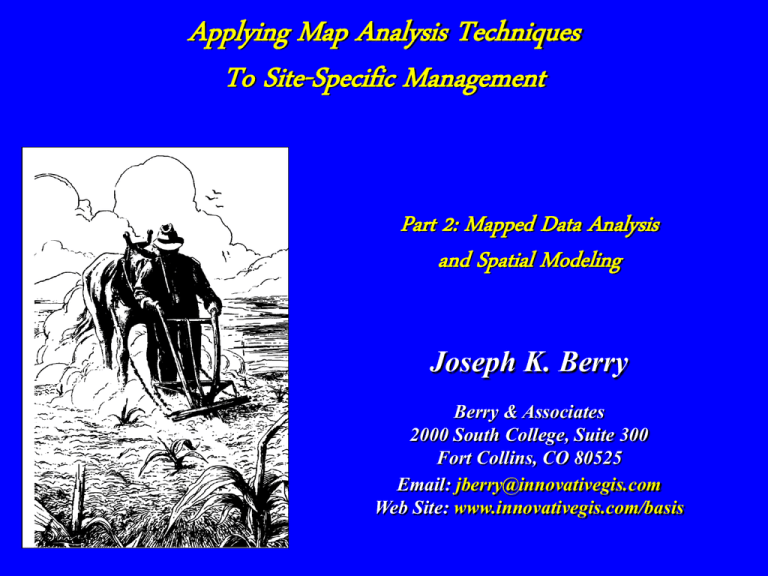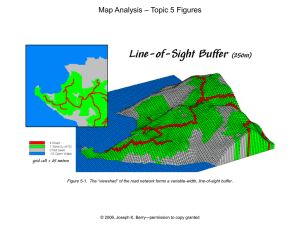- Berry and Associates Spatial Information Systems
advertisement

Applying Map Analysis Techniques To Site-Specific Management Part 2: Mapped Data Analysis and Spatial Modeling Joseph K. Berry Berry & Associates 2000 South College, Suite 300 Fort Collins, CO 80525 Email: jberry@innovativegis.com Web Site: www.innovativegis.com/basis Utilizing Remote Sensing for PF Collecting Remote Sensing Data: Demo of Video Mapping System Proximal Sensing: • Film Cameras • Video Mapping Aerial Remote Sensing: • Film Cameras • Video Mapping • Scanners A video camera is a broadband scanner Satellite Imaging: • Scanners Normalized Density Vegetation Index (NDVI)… plant vigor (Berry) Geo-Registration of Imagery Geo-registration is facilitated by GPS mapping ground features visible in the image • Intersections • Well pivots • Building corners • Grain bins, etc. Dycam Image + GPS Video Survey “Raw” Aerial Imagery (Preliminary study, Colorado State University, Soil and Crop Sciences ) Geo-Registered Result = Georegistered image/data …”rubber-sheet” corrections remove image geometric distortions …in effect, it is like printing the image on a rubber sheet then stretching the image to fit the GPS features …inside Cessna, M-VMS, Dycam, 35mm, camcorder and battery Dycam Belly-Port Camcorder and battery (Preliminary study, Colorado State University, Soil and Crop Sciences ) M-VMS Related Spatial Technologies (RS) [3] [1] …Electromagnetic Spectrum (Light+) [4] …incoming light is preferentially absorbed (reflected) depending on plant physiology [2] Species Photosynthesis Water Content (Berry) Linking NDVI to Nitrogen Levels NDVI Nitrogen Treatment …there appears to be a strong relationship between NDVI measurements from remotely sensed data and nitrogen application levels (Preliminary study, Wright, Red Hen Systems,) Delineating Zones Visible differences in an aerial image can be used to delineate portions of a field that have consistent texture and color (Management Zones). The zones are assumed to have consistent levels for each of the field’s driving variables (uniform conditions) (Wright & Berry) Mgt Zones vs. Map Surfaces …the bottomline …both approaches “carve” a field into smaller pieces to better represent the unique conditions and patterns occurring in the field. Zones pre-partitions it into relatively large, irregular areas that are assumed to be homogenous—discrete polygons. Surfaces, on the other hand, process field samples for an estimate of each factor at grid cells throughout a uniform analysis grid—continuous gradient. …relationships among Surfaces (data layers) are easily investigated Air Photo (soil color) No map analysis is possible with Management Zones (Berry) RS Imagery as GIS Data Layers A RS image is just a “shishkebab of numbers” like any other grid map (raster) Image 52 NIR (R) 46 Red (G) 148 26 (Beyond our sight) Color Infrared 34 44 Remote sensing images are composed of numbers, just like any other map in a grid-based GIS… “Mapematical Processing” 43 Green (B) 57 P 312 K 257 7.5 7.2 etc. ph (Berry) The Precision Farming Process As a combine moves through a field 1) it uses GPS to check its location then 2) checks the yield at that location to 3) create a continuous map of the yield variation every few feet. This map 4) is combined Steps 1)–3) with soil, terrain and other maps to derive a 5) “Prescription Map” that is used to adjust fertilization levels every few feet in the field On-the-Fly Yield Map 45.00 Step 4) Farm dB (Cyber-Farmer, Circa 1990) Prescription Map Map Analysis Step 5) 40.00 35.00 Zone 3 30.00 25.00 Zone 2 20.00 15.00 10.00 Zone 1 5.00 Variable Rate Application 5.00 10.00 15.00 20.00 25.00 30.00 (Berry) Step 3: Data Analysis Map Insights (Univariate-- within a single map) • Standard Normal Variable (SNV) Maps • Coefficient of Variation (CoffVar) Maps • Slope/Aspect (Spatial Derivative) Maps Relating Maps (Multivariate-- among maps) • Map Comparison Difference %Change Difference Tests • Corresponding Areas Coincidence Map Similarity Clustering • Prescriptive Statistics Regression Trend Surfaces Spatial Data Mining (Berry) Linking Data and Map Distributions A histogram depicts the numerical distribution A map depicts the geographical distribution …the data values link the two views— Click anywhere on the map and the histogram interval is highlighted; click on a histogram interval and the map locations are highlighted (Berry) Preprocessing and Map Normalization Preprocessing involves conversion of raw data into consistent units that accurately represent field conditions. Calibration - translates signals into measurements of crop production units, such as bushels per acre (measure of volume) or tons per hectare (measure of mass). Adjustments - “tweaking” the values… sort of like a slight turn on that bathroom scale to alter the reading to what you know is your true weight. Corrections - dramatically changes the measurement values, such as after the mass flow correction to GPS coordinates Normalization involves standardization of a data set, usually for comparison among different types of data. Goal - Norm_GOAL = (mapValue / 250 ) * 100 0-100 - Norm_0-100 = ((mapValue – min) * 100) / (max – min) SNV - Norm_SNV = ((mapValue - mean) / stdev) * 100 (Berry) Preprocessing and Map Normalization Applying the MapCalc equation… Norm_GOAL = (Yield_Vol / 250 ) * 100 …generates a standardized map based on a yield goal of 250 bushels/acre. This map can be used in analysis with other goal-normalized maps, even from different crops Since normalization involves scalar mathematics (constants), the pattern of the numeric distribution (histogram) and the spatial distribution (map) doesn’t change …same relative distributions (Berry) Assessing Localized Variation in Yield Scan Yield_Volume Coffvar Within 2 For Yield_Coffvar Where, Coffvar= Stdev/mean *100 The “Scan” operation moves a window around the yield map and calculates the Coefficient of Variation with a 2-cell radius of each location …higher values indicate areas with more localized variability (Berry) Assessing Rate of Change in Yield Slope 1997_Yield_Volume Fitted For Yield_Slope Where, Slope= Rise/Run *100 The “Slope” operation moves a window around the yield map and calculates the inclination (rate of change) in yield of neighboring cells …higher values indicate areas with rapidly changing productivity (Berry) Analysis“Within” A Surface Univariate analysis investigates relationships within a single map • Slope ~ rate of change (spatial derivative) of each surface element (grid cell) • Aspect ~ orientation (direction) of each surface element The slope and aspect of an elevation surface (altitude derived from a surveyed points or rectified orthophotos) identifies terrain steepness and orientation; example uses include road-building and water runoff modeling The slope and aspect of a barometric surface (air pressure gradient derived from a set weather station data) estimates wind speed and direction The slope and aspect of a thermal gradient in a lake (generated from remote sensing data of surface temperature) identifies rate and direction of cooling from a thermal input (nuclear powerplant ponds) The slope and aspect of a total revenue surface (generated by summing the cash flow stream for each surface element) identifies a marginal revenue surface which shows the spatial distribution of relative cash flow The slope and aspect of a proximity surface determines the speed and direction of the optimal movement in traversing each surface element …what would the slope of a slopemap show? …the aspect of a slopemap? (Berry) Analysis“Within” A Surface …continued Univariate analysis investigates relationships within a map surface • Aggregation ~ sum of the values for all or a portion of the surface elements (spatial integral); example uses include cut/fill calculations in road building and total yield estimates in precision farming • Coefficient of Variation ~ localized variation surrounding each surface element (surface roughness) • Mathematical Translations ~ scalar arithmetic, logarithmic, trigonometric and logical operations; example use of taking the cosine of the zenith angle formed between the sun’s position and each elevation surface element to calculate insolation (sun energy at each location) • Statistical Operations ~ describe and characterize a surface Descriptive statistics (min. max, range, median, mode, mean, skewness…) Similarity assessment (spatial autocorrelation) Predictive statistics (map generalization and interpolation) Accuracy assessment (residual analysis of how well a surface fits a data set) • Other “Stuff” ~ standard Normal Variable Surface; pattern recognition filters (Berry) Data Analysis (Visual comparison) Visual Analysis of 2D Maps Top-soil Phosphorous Bottom-soil Phosphorous …so what do these maps tell you (Data Analysis)? …what management actions should be taken and where (Spatial Modeling)? (Berry) Data Analysis (Map-ematical comparison) Mapped Data Analysis of Map Surfaces Top-soil Phosphorous Phosphorous Difference Bottom-soil Phosphorous …Top-Bottom values are subtracted for each location (Map-ematics)? (Berry) Data Analysis (Difference map) Visualizing Difference Map (2D) …add more Phosphorous just where it is needed (Spatial Modeling)? (Berry) Data Analysis (visually comparing maps) What differences do you see? …where did yield change significantly? …where did it stay about the same? (Berry) Data Analysis (comparing discrete maps) (Berry) Data Analysis (discrete maps vs. continuous surfaces) Discrete maps= intervals Continuous surfaces= values (Berry) Comparing Map Surfaces (Difference map) 1997_Yield_Volume - 1998_Yield_Volume Yield_Diff Map Variables… map values within an analysis grid can be mathematically and statistically analyzed …green indicates areas of increased production …yellow indicates minimal change …red indicates decreased production (Berry) Data Analysis (assessing spatial patterns) What spatial relationships do you see? …do relatively high levels of P often occur with high levels of K and N? …how often? …where? (Berry) Data Analysis (assessing spatial patterns) Data Clustering identifies of similar data patterns– Management Zones …the “data shishkebab” for each grid location is sent to a statistical algorithm that divides the data set into groups that are 1) as similar within each group and 2) as different between groups as possible (Berry) Investigating Surface Correlation (predictive model) Histogram/Map View Data Space (magnitude of values) are linked to Geographic Space (position of values) Histogram/Map View Data Space (joint magnitude of values) are linked to Geographic Space (position of values) (Berry) Investigating Surface Correlation (error analysis) …a predicted surface is compared to actual data (% difference map) for an assessment of overall performance and spatial pattern of errors. In this instance, the model is a good predictor within the partitioned area but poor along the west and north edges. (Berry) Data Analysis (establishing relationships) On-Farming Testing — Investigating the Effects of Alternatives (Berry) Step 4: Spatial Model Spatial Data Mining —new technology (CART) that is based on large sample size, repetitive data grouping and data driven to develop more accurate prediction equations than traditional statistics Knowledge-Based Relationships — evaluates spatial relationships given input map data • Look-Up Table If-Then Rules Expert Systems • Evaluating Functions Equations • Optimization Techniques Linear Programming Induction Modeling Genetics Modeling Tessellation (Berry) Precision Farming’s Big Picture …a new application of the Spatial Technologies …that utilizes spatial relationships in a field for site-specific management (Berry) So Where Are We in Precision Farming? (Berry) Underlying Issues In Precision Farming ...Gaps in Our “Thinking” • Limited Approach – Mapping vs. Data Analysis; Tools vs. Science • Science Link – “Scientific Method” Doctrine, The “Random” Thing, Appropriate Driving Variables, Correlation vs. Causation • Market Confusion – Empirical Verification, Economic Validation, Rationalization (Productivity vs. Stewardship) The Environmental Trump Card (Berry) Micro Terrain Analysis (Slope and Flow) Characterizing Slope A digital terrain surface is formed by assigning an elevation value to each cell in an analysis grid. The “slant” of the terrain at any location can be calculated— inclination of a plane fitted to the elevation values of the immediate vicinity Characterizing Surface Flow A map of surface flow is simulated by aggregating the “steepest downhill paths” from each cell— confluence Slope and Flow maps draped over vertically exaggerated terrain surface (Berry) Micro Terrain Analysis (Slope and Flow) Calibrating Slope and Flow Classes: Areas of Gentle, Moderate, and Steep slopes are identified; areas of light, moderate and heavy flows are identified (Berry) Micro Terrain Analysis (a simple erosion model) Determining Erosion Potential: The slope and flow classes are combined into a single map identifying erosion potential (Berry) Micro Terrain Analysis (extending the erosion model) Simple Buffer Effectively far away, though right near a stream …how can that be? …what about different soils? …what about roughness? …or time of year? (Berry) Precision Farming… an Oxymoron? What are your thoughts… Are there spatial variations in agricultural fields? Is our technology able to “precisely” measure the spatial variations? Can we derive and validate the spatial relationships in the patterns? Can we develop and implement spatially-based management actions? Are you burnt out yet? (Berry) More Information on PF Data Analysis PF Case Study (uses MapCalc Learner software) …the MapCalc Learner CD contains a copy of the Precision Farming Primer and the agriculture data set used in the case Study www.redhensystems.com www.innovativegis.com/basis Online text and Case Study www.agriculture.com/technology/ Online articles and active discussion forum on technology (Berry) Online PowerPoint Slide Set www.innovativegis.com/basis …select Precision Farming Primer then click on Appendix E …tuned for Internet Explorer 4.0+ and can have problems with some Netscape versions View in “Medium Text” mode; size window to fit the slides (Berry)







